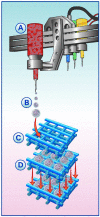Adult Stem Cells Spheroids to Optimize Cell Colonization in Scaffolds for Cartilage and Bone Tissue Engineering
- PMID: 29693604
- PMCID: PMC5983745
- DOI: 10.3390/ijms19051285
Adult Stem Cells Spheroids to Optimize Cell Colonization in Scaffolds for Cartilage and Bone Tissue Engineering
Abstract
Top-down tissue engineering aims to produce functional tissues using biomaterials as scaffolds, thus providing cues for cell proliferation and differentiation. Conversely, the bottom-up approach aims to precondition cells to form modular tissues units (building-blocks) represented by spheroids. In spheroid culture, adult stem cells are responsible for their extracellular matrix synthesis, re-creating structures at the tissue level. Spheroids from adult stem cells can be considered as organoids, since stem cells recapitulate differentiation pathways and also represent a promising approach for identifying new molecular targets (biomarkers) for diagnosis and therapy. Currently, spheroids can be used for scaffold-free (developmental engineering) or scaffold-based approaches. The scaffold promotes better spatial organization of individual spheroids and provides a defined geometry for their 3D assembly in larger and complex tissues. Furthermore, spheroids exhibit potent angiogenic and vasculogenic capacity and serve as efficient vascularization units in porous scaffolds for bone tissue engineering. An automated combinatorial approach that integrates spheroids into scaffolds is starting to be investigated for macro-scale tissue biofabrication.
Keywords: adult stem cells; biofabrication; building-blocks; scaffolds; spheroids.
Conflict of interest statement
The authors declare no conflicts of interest.
Figures



References
-
- Kim S., Park H., Lee J., Na K., Lee E. pH-responsive starch microparticles for a tumor-targeting implant. Polym. Adv. Technol. 2018 doi: 10.1002/pat.4248. - DOI
Publication types
MeSH terms
LinkOut - more resources
Full Text Sources
Other Literature Sources

